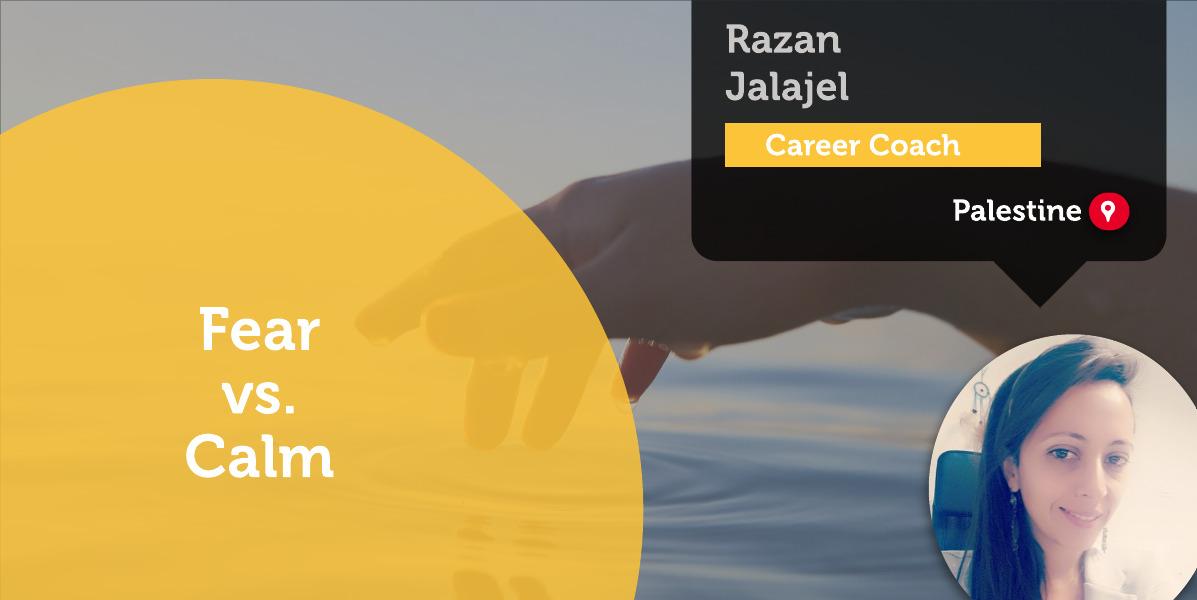A Coaching Power Tool Created By Razan Jalajel, Career Coach, PALESTINE
I promise you nothing is as chaotic as it seems. Nothing is worth diminishing your health. Nothing is worth poisoning yourself into stress, anxiety, and fear. Steve Maraboli
No one intentionally harms themselves, however, we sometimes tend to do so out of positive intentions. Usually, this comes in the form of repeating inappropriate or outdated patterns or behaviors. In the book “The Essential Guide to NLP”, the mind and body act as one system, accordingly, they affect each other. “What each of us thinks affects our individual psychology, as well as our health, and what we do to our bodies affects our feeling and thoughts” (T. Hoobyar, T.Dotz, S. Sanders, 2013).
Understanding Fear vs. Calm
More than 10 years of interviewing candidates, meeting with my team members, coaching managers and colleagues to present in front of crowds and chatting with friends about their life stories, paying attention to the words they tend to use “the word FEAR” is usually attached to their sentences: “I fear trying, I am afraid of taking action, I fear what people are going to say or react, I am afraid of making mistakes…”.
Fear
Fear is defined by the Cambridge Dictionary as “an unpleasant emotion or thought that you have when you are frightened or worried by something dangerous, painful, or bad that is happening or might happen”. Lisa Fritscher defined it as “a natural, powerful, and primitive human emotion. It involves a universal biochemical response as well as a high individual emotional response. Fear alerts us to the presence of danger or the threat of harm. Sometimes fear stems from real threats, but it can also originate from imagined dangers”.
Most of our emotions, interpretations, and reactions are automatic and the initial cause is out of our awareness. Fear usually arises when we start doubting ourselves and our abilities to perform an act or achieve something we desire.
Calm
Smile, breathe, and go slowly. Thich Nhat Hanh
On the other hand, calm is defined as “peaceful, quiet, and without worry”. A mind that is at peace or calm will cause the brain to produce “good” hormones, which in turn give the person a stable emotional state. There are different things a person can do to change from being in a state of “fear” to a state of “calm”, and thus, move from a disempowering to an empowering perspective.
- Imagining the worst: asking clients what is the worst that can come as a result of this fear? This helps clients notice that the fear is in their minds and gives them the courage to move away from it and offers them a sense of freedom and calmness,
- Look for evidence and for facts that may help question if this fear truly exists,
- Avoid trying to be perfect: allow yourself to make mistakes and enjoy the learning that will come out from failing and trying,
- Talk about it: this is very helpful, when we say things out loud and share, our thoughts we become more organized and the words sound becomes clearer.
Redesigning the Self Through Fear vs. Calm
Discovering some of the words and feelings we hold inside and replacing them with new empowering terminology and thoughts will enable redesigning the self. NLP proposes that for us to understand what is causing this fear, we may slow down the mental movie to easily discover the cue that produced a feeling (S. Knight, 2009).
Digging deep with clients who are stuck in making progress, and as a coach being fully present and focusing on the terminology being used when the word fear or afraid appears; the powerful question “what would it look like if you eliminate this fear is causing your hesitation?” The feeling of calmness and power that results from putting clients in this state of mind truly empowers them and supports them in moving forward in overcoming the disempowering feeling and puts them in a peaceful state of mind that enables them to start preparing for taking action.
Understanding NLP has helped me start being aware of this FEAR among other words that are being used, and question the effect it has on individuals’ progress. In addition, applying NLP concepts and techniques can be very helpful for taking initiative and making more concrete decisions of how we want to react to events in our lives. As per the book The Essential Guide to Neuro-Linguistic Programming; positive change comes from adding resources, removing fear adds a choice but it doesn’t eliminate it (T. Hoobyar, T.Dotz, S. Sanders, 2013).
The good news is that we can all be more of who we want to be. Unfortunately, some people give up after a few trials and accept that they are not capable of a change. I hear clients say during the first few sessions that “we are who we are and we cannot change”. Luckily this is not true! If what a person is doing is not working, they can try something new. This doesn’t guarantee success, but not failure. Fear may cause individuals to fail because they will quit trying.
- List down some of the disempowering terminologies you may be using.
- Write down an incident where you have stuck and the reason behind it was a fear of something.
- How will you practice moving from a state of fear to a state of calm?
- What tools you may consider using to feel more empowered?
References
Lisa Fritscher, What is Fear? https://www.verywellmind.com/the-psychology-of-fear-2671696
Cambridge Dictionary: https://dictionary.cambridge.org/dictionary/english/worried
Sue Knight, NLP At Work Neuro-Linguistic Programming- The essence of Excellence
Tom Hoobyar and Tom Dotz with Susan Sanders, The Essential Guide to Neuro-Linguistic Programming
